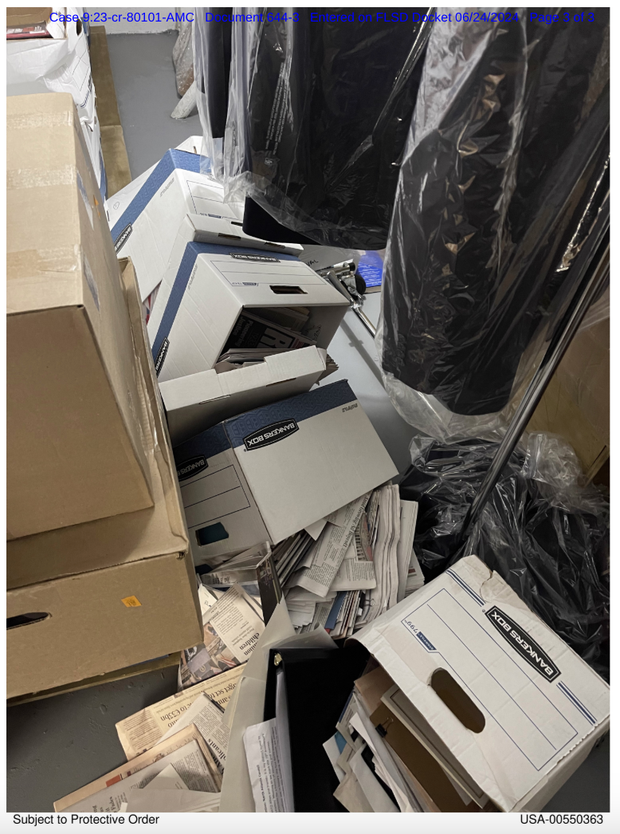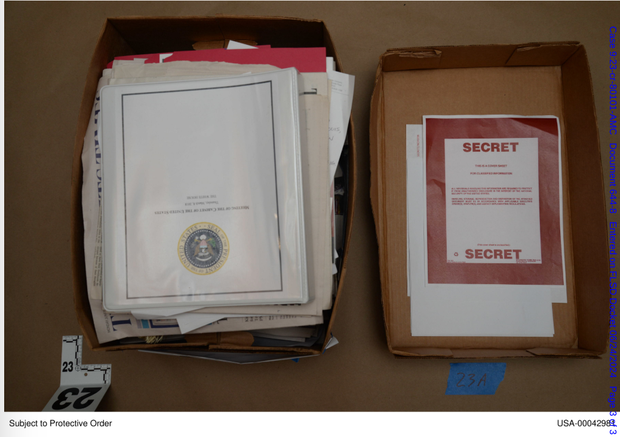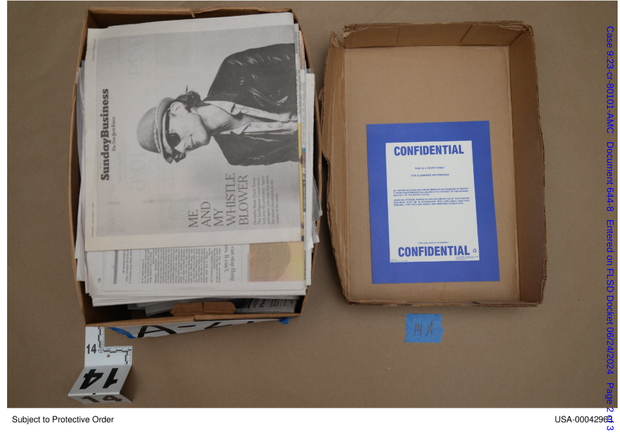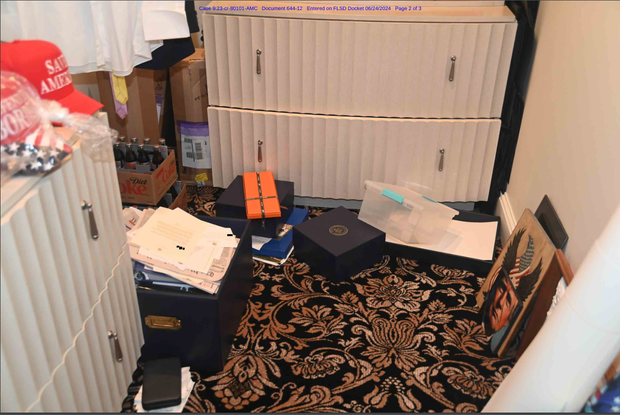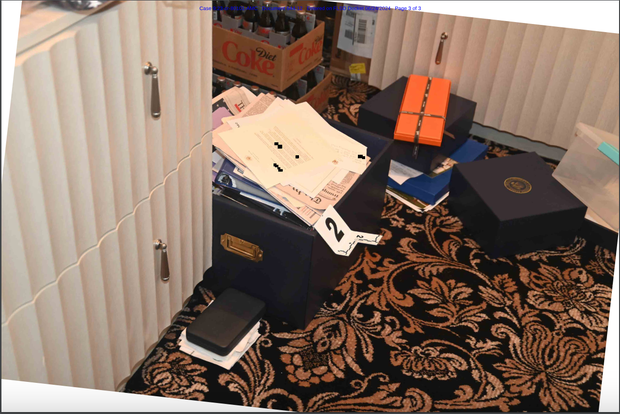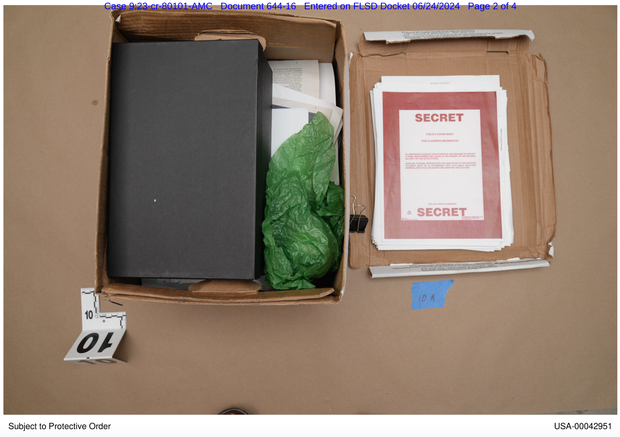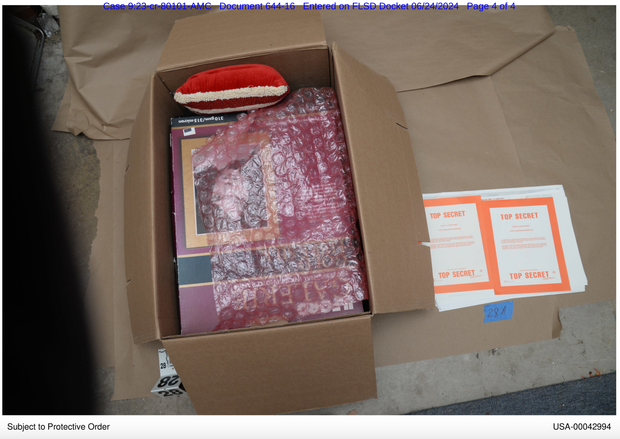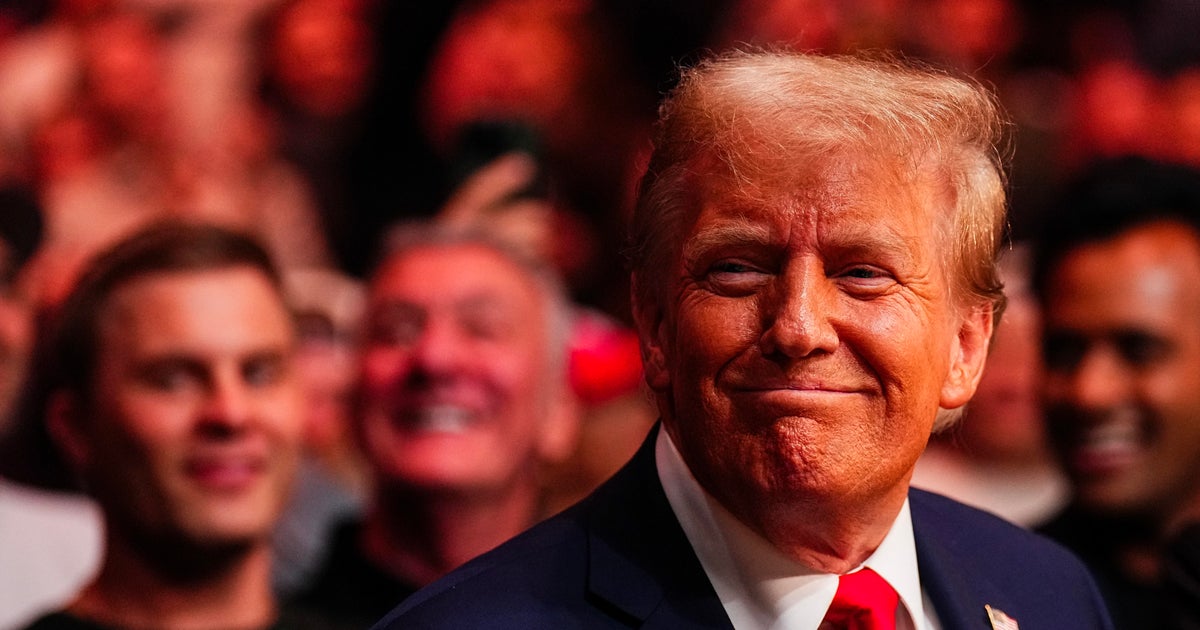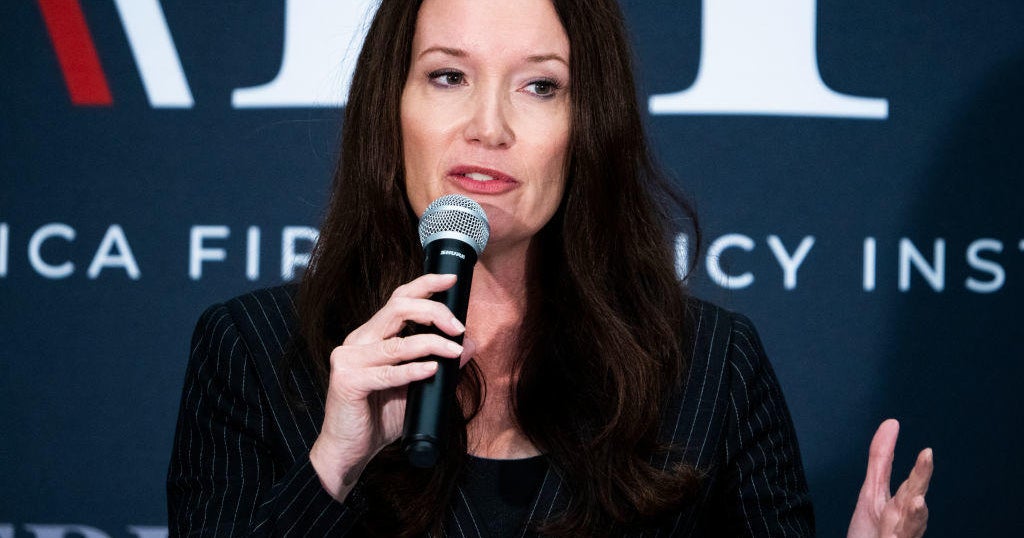CBS News
Newly released photos from FBI’s Mar-a-Lago search show Trump keepsakes alongside sensitive records

Washington — Newly revealed photographs taken by the FBI during its August 2022 search of former President Donald Trump’s South Florida resort shed further light on how the former president kept keepsakes from his time in office alongside documents bearing classification markings.
The photos, some of which had not been publicly released, were included as exhibits accompanying a Monday court filing from special counsel Jack Smith in the ongoing federal case against Trump in South Florida. Prosecutors have accused the former president of mishandling records containing the nation’s secrets after leaving the White House in January 2021 and obstructing the Justice Department’s investigation.
Trump was charged with 40 counts, including the unlawful retention of national defense information, and has pleaded not guilty. His presidential campaign did not immediately return a request for comment on Smith’s latest filing.
The filing from Smith’s office is in response to an effort by Trump to toss out the indictment and suppress all evidence seized during the court-authorized search of Mar-a-Lago. More than 100 documents bearing classified markings were recovered by the FBI in August 2022, and 21 of the records underlie counts of willful retention of national defense information that Trump is charged with. In all, federal investigators collected over 300 sensitive government records during their investigation into the former president.
Trump has argued that the FBI agents who executed the search warrant failed to maintain the order of the documents as they were found and did not take photos to show the sequence of records in each box containing them.
The special counsel acknowledged in a May 3 filing that there were some boxes where the documents were not in the same order as they were at the time of the FBI’s search. But prosecutors have contended the alterations were inconsequential to the underlying conduct Trump and his two codefendants are accused of and wrote “where precisely within a box a classified document was stored at Mar-a-Lago does not bear in any way” on the defendants’ ability to properly examine evidence.
Trump’s legal team has claimed that the failure to keep the documents intact and the order maintained violated his due process rights. They accused prosecutors of withholding information about the records’ sequence because it would undercut their claim that Trump knew classified documents were stored in the boxes alongside other personal items and willfully retained them after his presidency.
Smith’s team, though, argued in his latest filing that there is no basis for throwing out the charges against Trump because of a disruption of the precise order of documents seized from Mar-a-Lago.
“Trump personally chose to keep documents containing some of the nation’s most highly guarded secrets in cardboard boxes along with a collection of other personally chosen keepsakes of various sizes and shapes from his presidency,” prosecutors on the special counsel’s team said.
They accused the former president of maintaining the boxes containing sensitive material in a “haphazard manner” and said the FBI agents who conducted the search “did so professionally, thoroughly, and carefully under challenging circumstances.” Smith is separately seeking to bar Trump from making public statements that endanger law enforcement officers involved in the case. U.S. District Judge Aileen Cannon, who is presiding over proceedings, did not seem receptive to prosecutors’ arguments to modify the conditions of his release during a hearing on the matter Monday.
See the photographs taken by the FBI during its search of Mar-a-Lago and included in Smith’s filing:
Justice Department
Justice Department
The photos taken by Walt Nauta, an aide to Trump, in late December 2021 show boxes in a storage room at Mar-a-Lago that had fallen over, their contents spilled onto the floor. Nauta was also charged by Smith in the documents case and has pleaded not guilty.
Justice Department
Prosecutors said that one of those fallen boxes, identified in court filings as A-35, contained a classified record that the FBI recovered during its August 2022 search. A photo taken by the FBI during the search shows stacks of boxes, including A-35, in the storage room at Mar-a-Lago, roughly eight months after Nauta sent a text message that included the images of the fallen boxes.
Smith said in his filing that the classified record in box A-35 underlies Count 8 of the indictment, which describes the document as dated Oct. 4, 2019, and concerns “military capabilities of a foreign country.” The record has a “SECRET//REL TO USA, FVEY” classification marking, according to the indictment. FVEY is the Five Eyes intelligence alliance comprised of Australia, Canada, New Zealand, the U.S. and the United Kingdom.
Justice Department
Justice Department
During the search of Mar-a-Lago, a group of agents and members of the so-called Evidence Response Team reviewed the boxes from the storage room to look for any documents bearing classification markings that were subject to seizure, according to Smith’s team. If such a record was found, the team member removed it, separated it, recorded the box where it was located and replaced the sensitive document with a placeholder sheet, prosecutors explained in their filing.
That placeholder sheet was a preprinted classified cover sheet, but after agents ran out of those cover sheets, they used blank pieces of paper with “handwritten annotations to identify the document,” according to Smith’s filing.
As part of the process, the Evidence Response Team took photos of the documents, with the cover sheets added by FBI agents, next to the box they were found in, prosecutors wrote.
Justice Department
Justice Department
Justice Department
In addition to searching the storage room, the FBI also went through the “45 Office,” which consisted of an anteroom where staff had desks, the former president’s office, a closet attached to Trump’s office, and two bathrooms.
Agents with a filter team, which first looked for any material that might be deemed privileged, found in the closet a “blue, covered, leatherbound box full of various papers, including numerous newspapers, newspaper clippings, magazines, note cards of various sizes, presidential correspondence, empty folders, and loose cover sheets for classified information, as well as documents marked classified,” according to the special counsel’s filing.
The filter team member then alerted the case team, whose agents were investigating the case, that documents marked classified had been discovered in the box, and two agents went through it, the filing states. They found “numerous” documents with classified markings, some of which had classification cover sheets attached, as well as loose cover sheets, the special counsel’s team said.
The FBI took photos of the blue box with its cover off, prosecutors wrote.
Justice Department
Justice Department
Justice Department
Smith and his team argued in his filing that the contents of the boxes belonged to Trump and no one else, and said agents going through them during the Mar-a-Lago search found keepsakes “valuable only to Trump.”
Prosecutors wrote that the boxes “had no apparent organization whatsoever” and contained an array of items: clothing, picture frames, magazines, shoes, newspapers, newspaper clippings, greeting cards, binders, Christmas ornaments and correspondence. Photos taken by the FBI show the boxes and some of their contents to “provide a sense of the variety of items” in them, with classified cover sheets positioned alongside the boxes, according to Smith’s filing.
Katrina Kaufman contributed to this report
CBS News
In praise of Seattle-style teriyaki

Watch CBS News
Be the first to know
Get browser notifications for breaking news, live events, and exclusive reporting.
CBS News
Gazan chefs cook up hope and humanity for online audience

Renad Atallah is an unlikely internet sensation: a 10-year-old chef, with a repertoire of simple recipes, cooking in war-torn Gaza. She has nearly a million followers on Instagram, who’ve witnessed her delight as she unpacks parcels of food aid.
CBS News
We interviewed Renad via satellite, though we were just 50 miles away, in Tel Aviv. [Israel doesn’t allow outside journalists into Gaza, except on brief trips with the country’s military.]
“There are a lot of dishes I’d like to cook, but the ingredients aren’t available in the market,” Renad told us. “Milk used to be easy to buy, but now it’s become very expensive.”
I asked, “How does it feel when so many people like your internet videos?”
“All the comments were positive,” she said. “When I’m feeling tired or sad and I want something to cheer me up, I read the comments.”
We sent a local camera crew to Renad’s home as she made Ful, a traditional Middle Eastern bean stew. Her older sister Noorhan says they never expected the videos to go viral. “Amazing food,” Noorhan said, who added that her sibling made her “very surprised!”
After more than a year of war, the Gaza Strip lies in ruins. Nearly everyone has been displaced from their homes. The United Nations says close to two million people are experiencing critical levels of hunger.
Hamada Shaqoura is another chef showing the outside world how Gazans are getting by, relying on food from aid packages, and cooking with a single gas burner in a tent.
Shaqoura also volunteers with the charity Watermelon Relief, which makes sweet treats for Gaza’s children.
In his videos online, Shaqoura always appears very serious. Asked why, he replied, “The situation does not call for smiling. What you see on screen will never show you how hard life is here.”
Before dawn one recent morning in Israel, we watched the UN’s World Food Program load nearly two dozen trucks with flour, headed across the border. The problem is not a lack of food; the problem is getting the food into the Gaza Strip, and into the hands of those who desperately need it.
The UN has repeatedly accused Israel of obstructing aid deliveries to Gaza. Israel’s government denies that, and claims that Hamas is hijacking aid.
“For all the actors that are on the ground, let the humanitarians do their work,” said Antoine Renard, the World Food Program’s director in the Palestinian territories.
I asked, “Some people might see these two chefs and think, well, they’re cooking, they have food.”
“They have food, but they don’t have the right food; they’re trying to accommodate with anything that they can find,” Renard said.
Even in our darkest hour, food can bring comfort. But for many in Gaza, there’s only the anxiety of not knowing where they’ll find their next meal.
For more info:
Story produced by Mikaela Bufano. Editor: Carol Ross.
See also:
“Sunday Morning” 2024 “Food Issue” recipe index
Delicious menu suggestions from top chefs, cookbook authors, food writers, restaurateurs, and the editors of Food & Wine magazine.
CBS News
A study to devise nutritional guidance just for you

It’s been said the best meals come from the heart, not from a recipe book. But at this USDA kitchen, there’s no pinch of this, dash of that, no dollops or smidgens of anything. Here, nutritionists in white coats painstakingly measure every single ingredient, down to the tenth of a gram.
Sheryn Stover is expected to eat every crumb of her pizza; any tiny morsels she does miss go back to the kitchen, where they’re scrutinized like evidence of some dietary crime.
Stover (or participant #8180, as she’s known) is one of some 10,000 volunteers enrolled in a $170 million nutrition study run by the National Institutes of Health. “At 78, not many people get to do studies that are going to affect a great amount of people, and I thought this was a great opportunity to do that,” she said.
CBS News
It’s called the Nutrition for Precision Health Study. “When I tell people about the study, the reaction usually is, ‘Oh, that’s so cool, can I do it?'” said coordinator Holly Nicastro.
She explained just what “precise” precisely means: “Precision nutrition means tailoring nutrition or dietary guidance to the individual.”
The government has long offered guidelines to help us eat better. In the 1940s we had the “Basic 7.” In the ’50s, the “Basic 4.” We’ve had the “Food Wheel,” the “Food Pyramid,” and currently, “My Plate.”
CBS News
They’re all well-intentioned, except they’re all based on averages – what works best for most people, most of the time. But according to Nicastro, there is no one best way to eat. “We know from virtually every nutrition study ever conducted, we have inner individual variability,” she said. “That means we have some people that are going to respond, and some people that aren’t. There’s no one-size-fits-all.”
The study’s participants, like Stover, are all being drawn from another NIH study program called All Of Us, a massive undertaking to create a database of at least a million people who are volunteering everything from their electronic health records to their DNA. It was from that All of Us research that Stover discovered she has the gene that makes some foods taste bitter, which could explain why she ate more of one kind of food than another.
Professor Sai Das, who oversees the study at Tufts University, says the goal of precision nutrition is to drill down even deeper into those individual differences. “We’re moving away from just saying everybody go do this, to being able to say, ‘Okay, if you have X, Y and Z characteristics, then you’re more likely to respond to a diet, and somebody else that has A, B and C characteristics will be responding to the diet differently,'” Das said.
It’s a big commitment for Stover, who is one of 150 people being paid to live at a handful of test sites around the country for six weeks – two weeks at a time. It’s so precise she can’t even go for a walk without a dietary chaperone. “Well, you could stop and buy candy … God forbid, you can’t do that!” she laughed.
While she’s here, everything from her resting metabolic rate, her body fat percentage, her bone mineral content, even the microbes in her gut (digested by a machine that essentially is a smart toilet paper reading device) are being analyzed for how hers may differ from someone else’s.
Nicastro said, “We really think that what’s going on in your poop is going to tell us a lot of information about your health and how you respond to food.”
CBS News
Stover says she doesn’t mind, except for the odd sounds the machine makes. While she is a live-in participant, thousands of others are participating from their homes, where electronic wearables track all kinds of health data, including special glasses that record everything they eat, activated when someone starts chewing. Artificial intelligence can then be used to determine not only which foods the person is eating, but how many calories are consumed.
This study is expected to be wrapped up by 2027, and because of it, we may indeed know not only to eat more fruits and vegetables, but what combination of foods is really best for us. The question that even Holly Nicastro can’t answer is, will we listen? “You can lead a horse to water; you can’t make them drink,” she said. “We can tailor the interventions all day. But one hypothesis I have is that if the guidance is tailored to the individual, it’s going to make that individual more likely to follow it, because this is for me, this was designed for me.”
For more info:
Story produced by Mark Hudspeth. Editor: Ed Givnish.
“Sunday Morning” 2024 “Food Issue” recipe index
Delicious menu suggestions from top chefs, cookbook authors, food writers, restaurateurs, and the editors of Food & Wine magazine.


